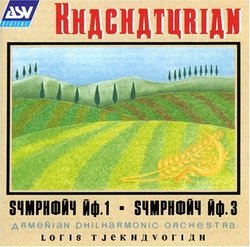Worth buying for the 1st Symphony
Benjamin R. Garrison | Lynnwood, WA United States | 08/12/2001
(3 out of 5 stars)
"Khachaturian's 1st symphony is a very laudable work that is hard to find. Since this is the only version I own, I would give it 5 stars. It's very full of the kind of Khachaturian lush orchestration that we've come to expect from this composer.The third symphony is very well done here, too. The trumpet work (and K's symphonies are known for loud brass sections) is splendid. The reason I can only give this work 3 stars is the organ. A HUGE disappointment. And it's not because Arthur Adamian doesn't do a fine job. He does. It's the recording itself. The organ simply isn't LOUD enough to hold it's own with the orchestra and that's very important in this work. The orchestra is in a daemonic race with the organ and the organ should be tweeking the nose of the string section. The orchestra ulitimately loses the 'race' and gives up. But if the organ isn't loud enough, what's the point? In this performance the orchestra wins by default. The organ is what makes this unique (and very underheard) symphony even more special. Compare this interpretation to Fedor Glushchencko conducting the BBC Philharmonic--on the Chandos label. That version milks the loudness and intensity of this score in a very dramatic and satisfying manner. It will surely be raising the short hairs on the back of your neck!"
Fifteen trumpets strong, one organ weak
Cory | Virginia | 03/02/2005
(4 out of 5 stars)
"Khachaturian's first symphony is greatly unrecognized, and unjustly so. The three movement symphony is the epitome of his orchestral writing. There are brilliant passages of excitement, with the expected loud brass, yet he also shows an ability to write soft and delicate, but persuasive, sections. The first movement is especially haunting, yet mystical, exploratory, both in the sense of the committed traveler and the agitated nomad. Half way through the first movement Khachaturian composes a fragile theme with the strings, backed by stratospheric winds and harp. The theme is gradually brought to life with even more support from the winds and strings, soon adding brass and percussion, moving the idea along.
The second and third movements are also interesting in their own right. Whereas the entire symphony is reminiscent of Gayaneh, the second movement is especially so, Khachaturian even directly quoting the Lullaby (or is it vice versa?).
Unfortunately this is the only recording at present of the first symphony. What a shame! Fortunately it is done well enough so as not to make a pressing demand for a second recording (though it would be nice). Of the three symphonies, the first has to be my favorite. And I respect those who favor the second and third, which are meritable each in their own right. But the loudness present in all three symphonies is here supplemented by a gentle introspectiveness that calls the listener to reconsider the cause of the loudness, whereas in the other two symphonies any softer portions do not demand the same gentleness, but rather affirm the loud war-likeness of the thundering portions.
The third symphony has one other recording available. Of the two, this is not the prefered recording. But both are so different that it is worth having both. I believe some material (and/or repeats) are cut in this recording, making it about five minutes shorter. While the fifteen trumpets blast the air, the organ makes a tiny puncture. Be prepared to have your hand on the volume dial before and after the organ solos. Interstingly enough, the soft organ creates a contrasting balance in the sections shared by the organ and the orchestra, where now the orchestra takes on the lead, and the organ accompanies (opposed to the other recording of the third).
If not the third, the first is definitely reason enough to get this CD. Out of all of the unfamiliar symphonies I've heard, this is one the best (as well as Kurt Atterberg's third and Howard Hanson's fourth, also favorites). If you enjoy the concept of an organ with the symphony, and particularly like Khachaturian's rough-edged usage of it contrariwise to Saint-Saen's organ symphony, look into Copland's first symphony, which utilizes an organ throughout the three movements."


 Track Listings (4) - Disc #1
Track Listings (4) - Disc #1
